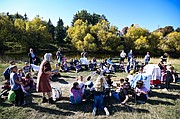Westward ho: Young pioneers traverse the Oregon Trail
HILARY MATHESON | Hagadone News Network | UPDATED 3 years, 1 month AGO
Under the bright afternoon sun, teams of excited Hedges Elementary School third-grade pioneers pulling covered wagons rounded the last bend before Dry Bridge Park, or, using their imaginations, the Oregon Trail, came into view.
Stepping onto a curb, the black pavement turned into the dusty trail beneath their feet as the third-graders, left behind the modern-day and tuned their imaginations to the 1800s.
Here and there a student donned a bonnet, wide-brimmed hat, apron, plaid or flannel button-up and boots. Their wagons were packed with food, water, tools and extra supplies for the journey ahead. Each group, which represented a family of settlers, had a $500 budget to spend in preparation.
“Our only stipulations were you have to buy an ox and you have to buy your wagon,” Hedges third-grade teacher Lexie Strouse said, the latter of which consisted of a contemporary children’s red wagon, to represent the wagon bed and a PVC pipe framework to represent the bows that held up the canvas cover.
What historically could take up to six months to travel from Missouri to Oregon, Strouse and fellow Hedges third-grade teacher Melaina Ames tried to emulate for their students in one afternoon.
“I actually used to do this with my two daughters and their cousins when they were little and we would go around the neighborhood and I thought it’d be fun to try,” Ames said.
This is the first time the teachers paired up to organize the large-scale experience for Hedges third graders.
“Every year we talk about the Oregon Trail, but this year, we’re trying to do transformational learning. That's our huge focus as School District 5. We want to try and make this a learning experience we can do year after year,” Strouse said.
THE EXPERIENCE was the culmination of three weeks of learning about the Oregon Trail in reading and social studies. Students learned about emigration, landmarks, modes of transportation and the different hardships faced during the grueling journey in hopes that new economic opportunity, free land, or a better life awaited at the end of the 2,170-mile trail.
As they headed to the hilltop, a student pointed out a discarded orange peel, imagining it to be buffalo chips. Before heading down the hill at Dry Bridge Park, Ames pointed out some ruts in the path.
“If you go right in that with your wheel you’re very likely to tip over your wagon or possibly break an axle, possibly break your wheel,” Ames said. “Yes, they did have to take wagons down these steep slopes but they put blocks on them to sort of slow them down.”
Some chose to move quickly, while others opted for a slow and steady pace such as third-grader Daisy Himsl’s group. At the bottom of the hill, Himsl swung her straw hat around the air with a cheer before placing it back on her head.
“If we didn’t hold onto the sides we would have went pretty fast,” she said.
Walking back to the wagon, Himsl began reorganizing supplies. Meanwhile, a student from each group goes to pick a “fate card” to learn what luck or misfortune may have befallen them during the span of a month.
“We have some food, water bottles and extra supplies. We have extra of this,” Himsl said, holding up a piece of cloth. “If we go through any spiky trees. If it cuts through then we can always put …”
Her explanation was cut short by a third-grader announcing bad news.
“Guys we lost a travel token,” the student said, reading the card. “A thunderstorm scared your oxen. You end up chasing [them] for several miles until you find them in a gully happily munching grass.”
OTHER GROUPS shared setbacks of losing food to hungry bears, which could mean starvation down the road — while others shared the good news of finding bags of cornmeal along the trail
Including starvation, emigrants faced many dangers — disease, drowning, hypothermia and accidents such as being run over by a wagon as one group described a teammate's foot being “broken” after “being run over” by a wagon wheel later on the trail. According to the Oregon-California Trails Association, it is estimated that one in 10 emigrants died during the crossing.
Ames pointed to the mountains and said settlers would be glad to see them and other landmarks, especially when traveling flat prairie land, to make certain they were headed in the right direction.
Filing back into line, the wagon train headed to one such landmark, Chimney Rock. The real Chimney Rock is located in Nebraska. The U.S. Geological Survey calculated the elevation as 4,225 feet above sea level in 1895, according to the National Park Service.
“It’s getting dusty,” one student said, the dry soil rising beneath striding or skipping feet and rolling wheels.
Another student pointed to an animal hole, imagining it to be a snake’s abode.
At their destination, Ames held up a photo of Chimney Rock.
“See how it looks like a chimney,” Ames said, holding up a laminated photo of the notable landmark. “If you had been traveling for a month across very flat plains it would be exciting to get here.”
The terrain, once grassy and flat, would become more rugged the closer settlers got to the Rocky Mountains, according to Ames.
WAITING FOR a teammate to get a fate card, third-grader Kelton Johnson waited with his group beneath a shady tree beside their wagon, which was missing its cover, exposing the framework underneath.
“I’m gonna say there was a big lightning storm,” Johnson said when asked how he would describe what happened in his travel diary. “It blew it away and it was really bad. Our food got wet and we had to eat wet food.”
Students then stopped to “hunt,” a roll of the dice, determining if they were successful or not. Within a minute a couple of cheers ring out in the air.
“I got a bison,” one student said with a shimmy.
Afterward, the students sit down to eat a real snack and a homegrown treat from one of the volunteers who produced a woven basket filled with bunches of tiny, but flavorful, “wild grapes.”
Another notable landmark the classes stop at to learn about is Independence Rock. The real Independence Rock, which Ames held up a photo of, is located in Wyoming. According to Wyoming Parks, it was a popular camping site and many emigrants inscribed their names in the “sturdy granite,” which stands 6,028 feet above sea level.
Finally, the wagon train reaches Fort Hall.
“We’re at Fort Hall, this is the last stop,” Ames called out. “This is the last stop before we cross the Sweetwater River and head up the Rocky Mountains.”
“We’re not in a circle, our oxen are about to escape,” she reminded the students.
The groups clustered together, counting money and rummaging through supplies to see what they should buy or barter for to make the last leg of their Oregon Trail experience before heading back to school where the coming day will be spent recording their adventurous journey in traveling diaries.
Reporter Hilary Matheson may be reached at 758-4431 or [email protected].
ARTICLES BY HILARY MATHESON

Christmas tradition: Business continues helping customers capture the holiday spirit
Snowline Acres owners Tom and Kristin Davis are approaching a decade of helping people celebrate the most wonderful time of the year.
Whitefish High School wins East Helena speech and debate tournament
Scoring 225 points, the Whitefish High School speech and debate team took first place at a weekend tournament.

Glacier High speech and debate team secures second in Bozeman
The Glacier High School speech and debate team secured second place, and Flathead High School, third in Bozeman.



